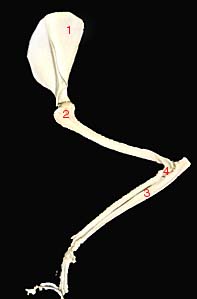Forelimb and Girdle
(Lateral view)

Click on the numbered bones for a closer view.
In this view the forelimb is in a flexed position.
For the sake of simplicity we will not address the bones of the wrist and paw in our study of the forelimb and girdle. As you study these bones pay special attention to the manner in which they articulate and the range of motion that is possible. Surfaces or processes where major muscles attach to the skeleton have been identified. Learning the names of these surfaces/processes may make it easier to learn the muscles.
|
Forelimb and Girdle (Lateral view) |
|
Click on the numbered bones for a closer view. In this view the forelimb is in a flexed position. |